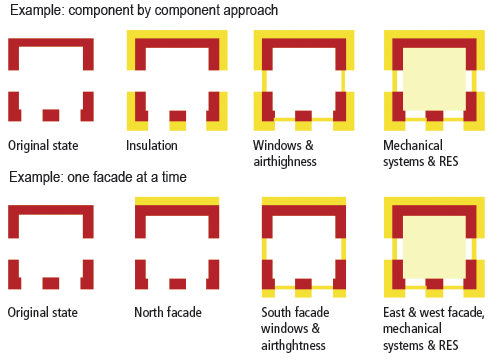- Home
- Energy Retrofits
- Projects
- Finance
- Financial workshops
- 1st Financial workshop - London, UK
- 2nd Financial workshop - Bratislava, SK
- 3rd Financial workshop - Copenhagen, DK
- 4th Financial workshop - Dublin, IE
- 5th Financial Workshop - Milan, IT
- 6th Financial Workshop - Leipzig, DE
- 7th Financial Workshop - Sofia, BG
- 8th Financial Workshp - Sophia, BG
- 9th Financial Workshop - Växjö, SE
- 10th Financial Workshop - Barcelona, ES
- 11th Financial Workshop - Barcelona, ES
- 12th Financial Workshop in Paris, France
- Final Financial Workshop
- Questionnaires
- Financial workshops
- Products
- Events/Awards
- Downloads
Step-by-step
While a comprehensive retrofit is always the best way to increase energy efficiency in existing buildings, it is unfortunately not always possible. Often, financial or other challenges get in the way - the reality can be more complex...

Each part of a building has its own life span. While the facade may be crumbling, the roof tiles may still be in great shape. Perhaps the heating system is shot, yet it will be another 20 years before the windows need to be replaced. Renovation measures can be time and resource intensive, which is why they are typically only carried out when absolutely necessary. Once the facade has been newly insulated and painted, it will typically stay that way, for better or worse, for the next generation or two. At the same time, energy efficiency measures for any one part of the building are always most affordable when that part is already in need of renovation. Step-by-step renovation is the natural result. One of the additional benefits of such an approach is that it gets the most out of each building component so that the initial investment is taken advantage of to its fullest. Also, renovation work is spread over a variety smaller measures is easier to finance.
If you do it, do it right from the start!
It is important to avoid missed opportunities by carrying out every retrofitting measure with an eye on quality and energy efficiency. It is also essential to remember that when we retrofit, we are not just improving aesthetics and reducing energy losses – we are also directly affecting a building’s moisture balance, air-flow, surface temperatures and much more besides.
Planning your retrofit
When conducting a step-by-step deep retrofit, a well-thought out plan can help ensure that the integrity of the building envelope throughout the renovation process. Improving airtightness, for example, without taking the insulation and ventilation into account, may lead to otherwise avoidable moisture problems. Especially if many years lie between various renovation steps, a plan covering present and future steps is essential.
A master plan can be tailored to fit the needs of the building and/or its owners/users. For example, it could specify the replacement of various components at various points in time or go facade by facade. However the plan is composed, it should define the type, quality and order of measures to be taken. The reward for steps carried out following an integrated plan: a future-proof, comfortable, sustainable building with consistently low running costs.


